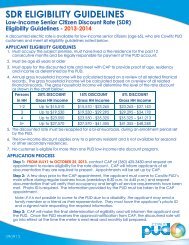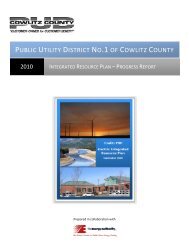- Cowlitz PUD
- Cowlitz PUD
- Cowlitz PUD
You also want an ePaper? Increase the reach of your titles
YUMPU automatically turns print PDFs into web optimized ePapers that Google loves.
Renewable Energy Credit (REC) MarketsBackgroundRenewable energy is not a new concept or technology; in fact, it has beenaround for centuries. Renewable energy resources such as water (hydro),biomass, wind, and solar are “cleaner” alternatives to fossil fuels and are notexhaustible. The benefits associated with renewable energy are being heavilypromoted as the global warming debate and initiatives such as the KyotoProtocol seek to reduce greenhouse gas emissions. As nations seek alternativeenergy sources to reduce GHG emissions, one can see the growth potential forrenewable energy based in the United States as it currently represents a smallpercentage of United States energy supply.Figure 8Renewable Energy Plays a Role in the Nation’s Energy Supply (2006)REC MarketAs nations, companies, and utilities seek to diversify their energy sources, theREC market will provide a source of “green energy” to meet Renewable PortfolioStandards (RPS). For example, states may have a RPS mandate that utilitieshave 20% of their generation come from renewable energy sources by aparticular year. In this instance, a utility can purchase RECs in a compliancemarket to meet this requirement. Businesses looking to be “green” may alsopurchase RECs in voluntary markets.The Energy Information Administration (EIA) reported in its May 1 st , 2008,renewable energy report that wind-generated and solar electricity posted thehighest growth rates among the renewable-generated sources. Wind energy hadthe highest growth rate during the past several years (45% in 2006 and 21% in22








